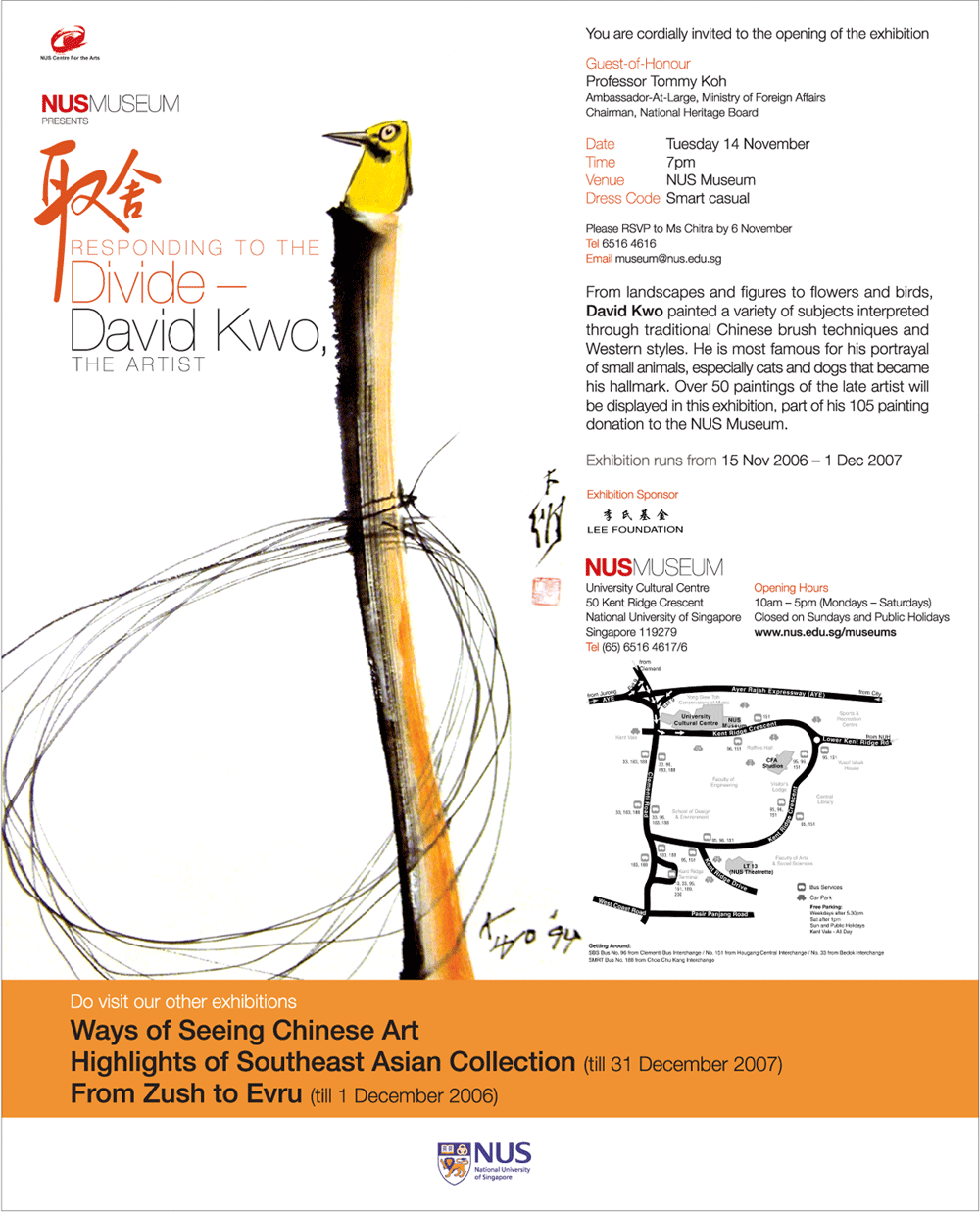
DAVID KWO
Dr David Kwo’s Retrospective Art Exhibition
Showcases the life works of Beijing-born Dr David Kow Da-Wei, a renowned artist
who specialises in blending Eastern and Western art techniques to create modern
prints with Chinese characteristics. Fri (29 Sept) to 15 Oct, 9am to 7pm. 80
Raffles Place, UOB Plaza 1, 37th and 38th storeys. Free.

The Art Of Building Bridges
(Source: By Clara Chow, The Straits Times/ANN)
Three years after the late Chinese ink painter David Kwo bequeathed his works to
the National University of Singapore, a selection of them can be seen by the
public.
The donated collection, worth around USD625,000, included many pieces from the
last two decades of his life.
He died of pancreatic cancer in 2003, at the age of 84.
China-born Kwo, an American citizen, was the first foreign artist to be granted
permanent residence here under the government's 1991 Foreign Talent Scheme.
From 1982 to 1983, he was a part-time lecturer in Extramural Studies at NUS.
More than 50 of the 105 paintings that he donated can be seen in an exhibition
called Responding To The Divide, on at the NUS Museum from tomorrow till Dec 1
next year.
Born in Beijing in 1919, he trained at the Institute of Fine Arts in Nanjing,
and studied under master painter Qi Baishi(齊白石).
In 1953, he went to the United States, where he was exposed to the works of
abstract expressionist artists such as Jackson Pollock.
The exhibition's curator, Michele Lynn Thompson, said the artist sought to build
a bridge between his native and adopted cultures.
"He blended the disciplined art of Chinese calligraphic brush strokes and
composition with Western emphasis on freedom, creativity and improvisation," she
said.
"This was Kwo's artistic tendency that would last a lifetime: the assimilation
of Eastern and Western techniques and an integration of his varied training and
influences."
The show is arranged thematically, with sections on traditional subjects in
nature, like plum blossoms, lotuses and bamboo; landscapes, such as Chinese
villages, the Three Gorges and the Great Wall; and animals, like Kwo's trademark
cats, dogs, birds, frogs and turtles.
His seminal 1957 painting of his black cat, Kim, won't be there though. The
original painting was given to his daughter, Dr Sophia Kwo, a plastic surgeon in
her late 40s.
A print of Kim, donated by the artist's student Chia Lay Yong, will be on
display instead.
An obvious choice for the retrospective, says Thompson, is Village Below
Huangshan - a traditional landscape set in an expanse of colour that draws the
viewer in.
Another of the curator's picks is Yellow Sparrow, a simple, lively composition
that shows a small sparrow perched on a pole.
The artist's wife Rita, 72, a retired metal trader who flew here from the US for
the opening of the exhibition on Tuesday, said, "He would have been very happy
about the exhibition. In his life, he cared only for his artistic reputation,
and not money.
"He didn't like much that Singapore, his adopted home, was very hot. But he
loved to eat durians. Most importantly, his art was appreciated here."